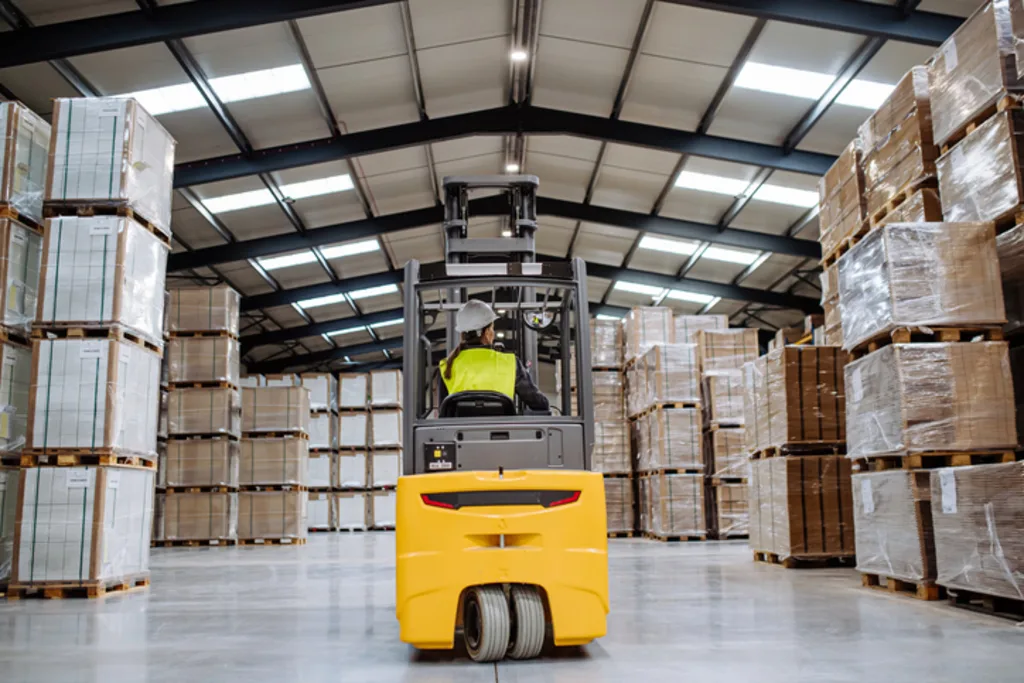Forklifts have come a long way
Maximising efficiency in your warehouse with innovative forklift technologies.

EFFICIENCY IS key in the fast-paced world of warehousing and manufacturing. Every second counts and any chance to speed up operations is valuable. Forklifts have come a long way from being just lifting machines. With the rapid progress of technology, they've been equipped with various cutting-edge tools that can be used to streamline processes, such as automation, telemetry systems, and energy-efficient models.
These advancements make it easier than ever to improve productivity rates while at the same time reducing costs and enhancing safety within warehouse and manufacturing environments.
Automation and Redefining Efficiency
There’s no doubt about it: c. Automated Guided Vehicles (AGVs) and Autonomous Mobile Robots (AMRs) are currently transforming this industry by navigating through warehouse spaces without human assistance. These smart machines run on sensors, cameras, and advanced algorithms that allow them to find the best routes possible while avoiding obstacles along the way.
1. Enhanced Safety
Because these automated systems require little or no human intervention at all, there's less element of risk involved when it comes to accidents or product damage. They operate tirelessly 24/7 without feeling tired like humans do, so workers can rest assured knowing that these automated systems will keep them safe while working around them. In addition to that, because there's less likelihood for things to go wrong due to human error, workspaces stay safer overall since fewer accidents would occur anyway.
If you add up all of these benefits along with the elimination of manual heavy lifting which decreases the chances of ergonomic injuries happening even further, then you'll understand how integrating automated systems can do wonders not only for a company's efficiency numbers but also for employee wellbeing.
2. Continuous Workflow
Another amazing thing about automation is that it allows facilities to operate 24/7 without needing any breaks whatsoever – much like how the machines themselves never get tired or need rest. This means that tasks and orders can be completed without stopping, leading to a continuous workflow and faster turnaround times.
No one likes it when their deadlines are missed, so by ensuring that operations are running smoothly with no interruptions, automated forklifts enable warehouses to stay on top of things and prevent any customer frustrations from bubbling up. Additionally, this feature also allows for smoother transitions between shifts as there’s no downtime needed to reset the workspaces. By keeping everything moving at a steady pace around the clock, facilities will also be able to keep up with peak periods when the demand for their products is through the roof – all while avoiding unnecessary overtime expenses or having to hire more staff members than needed.
3. Space Utilisation and Scalability
As stated above, automated systems navigate through aisles with precision and efficiency. They know exactly what they’re doing and where they’re going at all times right down to the inch – which leads us to our next point: maximising storage capacity in tight areas. Traditional manned forklifts take up a lot of extra space when moving things around because it's hard for human drivers to pinpoint exactly where their forks are without hopping off every time.
In turn, this causes lots of wasted areas within aisles since loads aren't stacked as tightly together as they could be due to safety concerns surrounding worker's legs being crushed underneath them. With automation though, these unsafe factors become obsolete as there are simply no workers in danger anymore!
To put it simply: When a machine doesn't have sensitive body parts that could potentially be crushed underneath its load, then it can stack items wherever it wants to find the most efficient use of space possible – even if that means leaving millimetres of room between each good stacked on top of each other. The utilisation of space is just one perk though; scalability is another huge benefit.
Telemetry Systems
There’s no doubt about it: Telemetry systems are here to change how warehouse managers oversee operations. These gems offer unparalleled visibility and control over forklift fleets. Here’s how:
1. Real-time Data Insights
Using IoT sensors and connectivity to their advantage, telemetry systems gather and send real-time data on forklift performance, maintenance requirements, and operator conduct. These invaluable insights empower managers to make well-informed decisions that optimise fleet operations.
With access to up-to-the-minute information about forklift usage and performance metrics, decision-makers can stay one step ahead of any inefficiencies or areas that need improvement. If it means identifying patterns of equipment misuse, predicting maintenance needs, or finding opportunities to improve operator training—real-time data is essential. Not only does it help maximise efficiency, but it'll significantly reduce costs too.
2. Predictive Maintenance
Instead of waiting until something breaks down or falls apart altogether before fixing it—telemetry systems analyse fuel consumption and usage patterns to enable predictive maintenance. By looking at historical records and real-time performance metrics, these systems can catch early signs of equipment wear or a potential malfunction. Once identified, maintenance teams schedule proactive preventive measures accordingly which ultimately minimises unexpected downtime and repairs that are heavy on the pocket.
This proactive approach not only guarantees consistent operation but extends a forklift’s lifespan as well—ensuring maximum returns on investments. In addition to that, this system is great for prioritising tasks based on urgency and severity so facilities can minimise disruptions during workflow and maintain peak operational efficiency. Ultimately though, the ability to predict malfunctions empowers warehouses to operate confidently knowing their equipment is reliable.
3. Productivity & Safety
By tracking operator productivity levels and safety compliance metrics such as adherence to speed limits or proper use of operating protocols—telemetry systems offer valuable insights into how things are being run in the facility i.e. is everyone working efficiently? Are they operating safely? With this data at hand, managers can then identify skill gaps or areas in need of improvement and create training programs tailored specifically to address those issues.
Addressing these issues will ultimately improve overall productivity and make the warehouse more efficient. Moreover, telemetry systems also track safety compliance metrics such as adherence to speed limits, proper use of safety equipment, and compliance with operational protocols.
Sustainability meets Productivity
Sustainable developments are being pursued in warehouses via energy-efficient forklift models. Here’s how:
1. Innovative Technologies
The use of lithium-ion batteries, regenerative braking systems, and energy-efficient motors in the design of models results in minimal energy usage and carbon footprint. This is because lithium-ion batteries are better than lead acid batteries for they take less time to charge, have a longer life span, and require less maintenance for them to keep working properly.
Also, regenerative braking systems operate by recovering kinetic energy that would otherwise be lost during braking to generate electricity that can be used elsewhere which leads to better energy efficiency as a whole.
Furthermore, efficient motors use cutting-edge technologies that optimise power application thereby lowering the amount of power consumed translating into reduced environmental impact. In this way, modern warehouses can lessen their dependence on fossil fuels and mitigate their carbon emissions. Thus, it not only supports corporate social responsibility initiatives but also contributes to long-term savings in costs as well as the preservation of the environment.
2. Cost Savings
Fuel-efficient forklifts save money because they emit less carbon dioxide into the atmosphere reducing electricity bills while also minimising repair costs. High consumption levels will see warehouses paying huge amounts of money for electricity over time hence lower levels of power usage translate directly into real financial gains in due course.
Besides this fact, there are some new technologies such as sensors and other advanced features control which need little or no maintenance at all for these types of machines compared with conventional counterparts. Cost is an additional consideration since low maintenance means cheaper repairs together with fewer breakdowns leading consequently to extra savings for those who run depots thus carrying out day-to-day business operations without any hitch at all times throughout the year; further keeping overhead costs down and increasing our competitiveness within industry circles among competitors.
3. Environmental Responsibility
The business case for investing in energy-efficient forklifts has never been stronger due to higher energy costs coupled with increasing regulation. This calls for warehouses which opt for models that are more friendly to the environment so that their carbon footprint can be checked on many fronts. As governments all over the world tighten their policies on emissions of greenhouse gases, modern technical solutions have become very crucial in terms of environmental requirements compliance failure which would result in fines and sanctions being imposed upon violators.
Conclusion
Innovation in forklift technology is revolutionising warehouse operations by enhancing efficiency, productivity, and sustainability. This progress includes automated interventions such as telemetry systems as well as using power-saving devices like Energy Star-rated lifts across various warehousing applications.
By doing so, distribution centres could consolidate their supply chain management while reducing costs related to transportation, labour, and stock-outs thereby gaining a competitive advantage within ever-changing settings where success may only come through the optimisation of operational efficiencies. Together with the rise in technological advances, warehousing will continue to advance toward improved productivity and efficiency.



